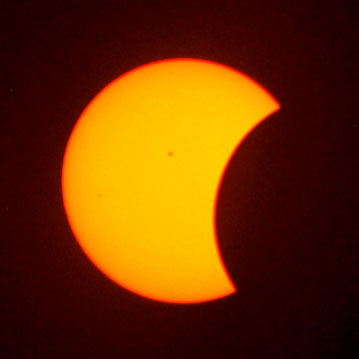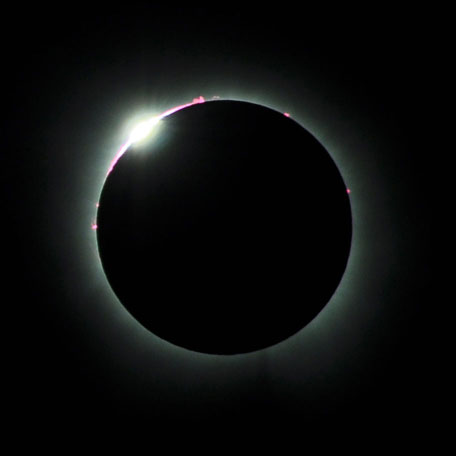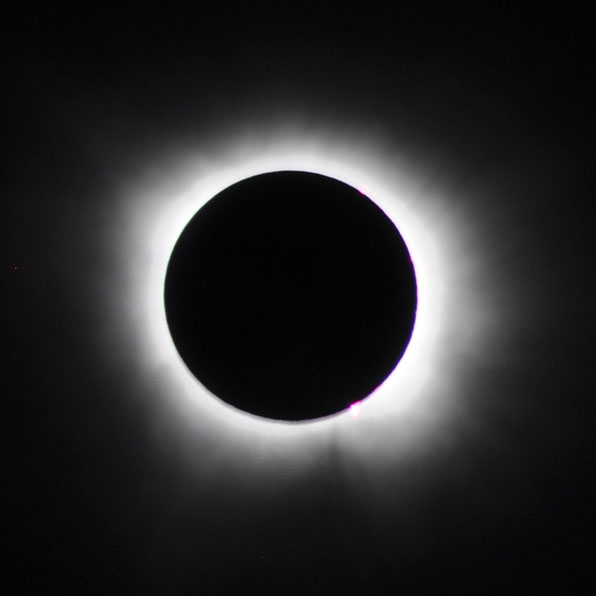-
Posts
3,258 -
Joined
-
Last visited
Content Type
Profiles
Forums
Developer Articles
KSP2 Release Notes
Bug Reports
Posts posted by Brotoro
-
-
1 hour ago, JoeSchmuckatelli said:
I was excited to see these - unfortunately they're not showing up
I'm sorry. Maybe KSP forum has a problem with my file naming conventions? Does the webpage linked below work for you?
-
I've been using my Quest 2 VR headset to look at 360 VR recordings people have posted of the eclipse. Most of them suffer from the same problem of the camera's auto-exposure system making things look brighter than they should, and overexposing the sun so all you see is a blob instead of the coronal ring. Still, not terrible for getting some idea of the event (especially the recordings with people around reacting to the sight). Venus and Jupiter could be seen. There are places where people say they can see shadow bands, but I couldn't make them out in the recording (the wavering bands are very low contrast in real life, and video does not capture them well. We had a sheet of cloth spread out on the ground and could see some after third contact…but it's not obvious).
-
1 minute ago, PakledHostage said:
The Straight of Gibraltar is on the centerline, yeah, and one could observe it from a relatively small ship there (because you only need to make a day trip out of it), but see my earlier comment about hyper inflated prices.
I was referring to the problem of lack of locations because of politically unstable areas. Big cruise ships out in the ocean circumvent that problem, and cruises are often not hyper expensive. They also have the advantage of being able to move the ship to an area forecast to be clear. I've never done an eclipse cruise before, but I have friends who have and thought they were great.
-
A selection of my eclipse photos. Taken from Midlothian, Texas. Nikon D90 300mm zoom telephoto. ASA 200. f/11.
A partial phase shot through a cheesy filter (made from the lens of some old eclipse viewing glasses, mounted in a cardboard frame). 1/30 sec. You can see the two sunspot groups that were easily visible on the face of the Sun.

Diamond ring just before second contact. 1/1000 sec. This shows the inner corona and solar prominences.

1/30 sec exposure showing middle of corona. The reason any eclipse photo has problems looking anything as cool as the naked-eye view is that your eye has a much larger dynamic range than a photograph, so the inner parts of the corona get washed out while the outer tendrils of the corona are too dim to register. One can take a lot of photos covering a range of exposures and then combine them in Photoshop...I did that with a sequence of photos I took of a 1999 eclipse, but it was a lot of effort and I didn't get good exposures of many intermediate times during this eclipse.

Below is a 0.6 sec exposure showing outer corona. The ghost image on the left is due to internal reflections in the lens. The corona shape for every eclipse I've seen has been different, and in this one the two spikes off to the left were most noticeable (although the dark rift at the bottom in the photo above was also interesting).

Diamond ring after third contact. The largest prominence was visible in the lower right during this half of the eclipse. You can see that we were fighting some clouds that were moving across the face at this time.
 3 minutes ago, PakledHostage said:
3 minutes ago, PakledHostage said:The problem I forsee with that eclipse is going to be cost. It's a long eclipse that passes over large areas of desert, but there are a lot of politically unstable areas along the path so everyone is going to be concentrated into a few areas (e.g. Morocco, Tunisia, etc.). Add to that the proximity to Europe with its large population of people with the means to go see the eclipse and it will probably result in some seriously inflated prices.
Cruise ships are a possible way around this problem.
-
I looked at a lot of cloud forecasts on various websites covering Texas for days and days before the eclipse, and the National Weather Services sites for Dallas/Fort Worth and for San Antonio helped me narrow down my choice to the DFW area (of my selected range I was willing to travel to). But the most accurate picture of the cloudiness for the particular site I chose were gotten from cleardarksky.com. I use that site a lot for nighttime observing, but it proved to accurately predict what was going to happen… although, I only looked at this source once I got down to choosing a final site 6 hours before totality. For example, the data looks like this (for a stored site Waxahachie, Texas, near where I was). When you click on that link, you'll get the upcoming predictions for that site, of course.
http://www.cleardarksky.com/c/WxhchTXkey.htmlyou can click on the little boxes in the Cloud Cover line to get details for that particular time. And it said there would be mostly cloudiness until about Noon, and then better conditions for Noon to 2PM, and then much clearer for a couple hours after that. Which is exactly what happened. Being armed with that info was a bit of solace during the early overcast times when we feared we might see nothing…since the trends unfolded as predicted.
-
I've seen four total solar eclipses, and this one was certainly the best. Part of that was the duration (over four minutes, whereas the others were two-and-a-fraction minutes)… this gives you more time to see things, so I was able to waste some time taking pictures (I really need a better light source to help with changing camera settings), and this was the first time I had a telescope to view totality.
But I think it looked so interesting because of all the clouds. All the previous eclipses I'd seen were with clear or mostly clear skies (maybe some high thin clouds). This time there were a lot of clouds surrounding us, so the horizon got much darker than normal. And the eerily lit up clouds flanking the other-worldly glow of the solar corona looked cool. Having Venus and Jupiter pop out so obviously at totality was also nice. I was able to find Aldebaran (since I wanted to see an actual star), but I couldn't see Mercury or the comet (too much high haziness, I think…plus, you don't have too much time to look for stuff). Binoculars were very helpful.
BUT, interesting as all those clouds made things, I'd feel better with a clear sky. Things looked really iffy during the initial partial phases. The Sun was blocked by clouds for ten or fifteen minutes at a time. Then when got a big blue hole in the clouds with twenty-five minutes to go until totality, it was a relief…until it became clear that those clouds at the bottom edge of the hole were going to get up by the Sun before totality (fast moving clouds). And one cloud blocked the Sun five minutes before totality…and the crowd wailed…but it was clear to me that it was going pass over the Sun quickly, and the other clouds were going either side. But, arrrrggghhh, the suspense leading up to totality was killing me. Will it be clear?? Will a cloud cover it at the last second?? So, even though the clouds looked cool…on the whole, I'd prefer a completely clear sky, thanks anyway.
-
Starlink satellites have cameras? I did not know this.
-
We are headed back to Abilene base camp via the back roads, which don’t seem very busy. Maybe the interstate is busy?
-
Success! Clouds on and off, but we got to see totality in hole. Nail-biting, watching the clouds. I also had my telescope, and looked at it during totality (and partial phases through filter). Prominences were good in binoculars.
-
Drive carefully. Clear skies!
-
Damn… my iPhone did a system update overnight, and that erased all my offline map data that I had updated into the Maps app. Re-downloading that gig of data now.
If you are going to be driving in the boonies, or in any area that may see cell data connections overwhelmed during eclipse day, it's a good idea to have your map app offline data downloaded.
-
On my way to Texas…but the forecast looks poor.
-
But an operational payload DISPENSER would be nice. And as long as you're going to pop out a test mass, it might as well have a camera on it to send back images of Starship.
-
Maybe they need an entry burn (like Falcon 9) to take some (entry) heat off the raptors, and allow them to relight at a lower oncoming dynamic pressure. But I don't have access to the engine telemetry like SpaceX does, so they will know a lot more about this.
But the booster was clearly all jinky before relight, so whatever is causing that needs to be dealt with (since it may be the cause of their difficulties).
-
I expected it to burn/breakup on reentry, but I still had fingers crossed that it maybe could do it.
-
No relight.
-
Glorious!
-
Onboard video…nice!
-
Go baby!
-
Winds look acceptable.
-
3 hours ago, Spaceception said:
Wait, abort! I can't believe I fell for that.
 Fake FAA account.
Fake FAA account.
I can take some solace that NSF fell for it too (their tweet was quickly deleted).
What are you talking about?
-
6 hours ago, sevenperforce said:
To be clear, you would definitely need continuous acceleration for settling regardless of whether you used a pump. The weight of a pump that can move tens of tonnes of liquid quickly is non-negligible, and neither is the weight of a sufficient power source.
In contrast, if you're transferring by constant ullage acceleration then you're only losing gas -- gas that would have to be displaced anyway as the destination tank is filled.
If you use pressure feed to move the propellant, you don't need a heavy pump. Energy source for heating propellant to provide the pressure could be a hot-gas thruster (using the thruster output to maintain ullage).
-
Super Heavy seemed to flip pretty fast. Maybe if they go a bit slower on the flip, they might be able to avoid propellant feed issues.
The failure of the Starship to reach SECO was more of a surprise, considering that it was ticking along fine for several minutes.
-
21 minutes ago, SunlitZelkova said:
I said “four flights with various levels of success but still failing” not “four flights with an unsuccessful first stage.”
It has yet to surpass N1 in that it hasn’t made it to orbit.
I believe there will be two more failures prior to a successful orbit. Successful Starship EDL is another question.
As I recall, the N1 never made it to staging. SH/SS has done that.



SpaceX Discussion Thread
in Science & Spaceflight
Posted · Edited by Brotoro
Yes. My watching of Falcon 9 launches have dropped precipitously after they no longer posted them on YouTube. I presume SpaceX just isn't interested in me watching their launches.
Also…I became much less interest in Starlink after I learned that I live in one of the few places in the U.S. where they won't sell me service.